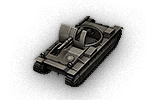Select your region to log in.
Crew:
- Commander (Radio Operator)
- Driver
- Gunner
- Gunner
- Loader
- Loader
Advantages:
- Gun range: stock: 850 m, top: 1050 m
- Can rotate its gun 360 degrees, like the SU-26
- High gun arc, comparable to Soviet artillery
- Massive ammo capacity with decent reload rate, can keep spamming shells as long as there is something spotted
- Low profile (although the gun shield may stick out of the smaller bushes)
Disadvantages:
- Poor accuracy
- Low alpha damage and splashing radius
- Open top, vulnerable to crew and module damage
- Low mobility and agility, gun traverse is also slow
- Paper armor, will get destroyed by tier II''s
Tank description:
The Birch Gun is a British tier 4 self-propelled gun.In the 1920s, British engineers explored the idea of an SPG on a tank chassis. Development of the vehicle started in 1923 at the Royal Arsenal, Woolwich. It was based on the Vickers Medium Mark II, the chassis of which could carry the required modules. A total of seven prototypes were manufactured from 1926 through 1927 and joined the Experimental Mechanised Force established on May 1, 1927. Later, the unit was disbanded, along with the SPG program.For all intents and purposes, the Birch Gun functions identically to the SU-26. Equipping a Camo Net would be very useful, since it will not have to turn its chassis when acquiring new targets (unless you want to snap to a target quickly, as the gun traverse is slow). Having a low profile not only helps in camouflaging, it also comes in handy when going into TD mode to fight off tanks that come too close. While the 25-pounder gun is marginally more powerful than the stock 18-pounder, its still anemic damage and low splash means that, for the most part, you will be doing double digit damage to anything with a reasonable amount of armour. However, it makes up for it with a good rate of fire like its predecessor the Sexton II, along with decent accuracy and a high gun arc to fire over obstacles.The Birch Gun marks the end of its British self-propelled gun line.
In the 1920s, British engineers explored the idea of an SPG on a tank chassis. Development of the vehicle started in 1923 at the Royal Arsenal, Woolwich. It was based on the Vickers Medium Mark II, the chassis of which could carry the required modules. A total of seven prototypes were manufactured from 1926 through 1927 and joined the Experimental Mechanised Force established on May 1, 1927. Later, the unit was disbanded, along with the SPG program.

 Русский
Русский English
English Russian region
Russian region North-american region
North-american region European region
European region Asia region
Asia region Korean region
Korean region


 0
0
 152 000
152 000